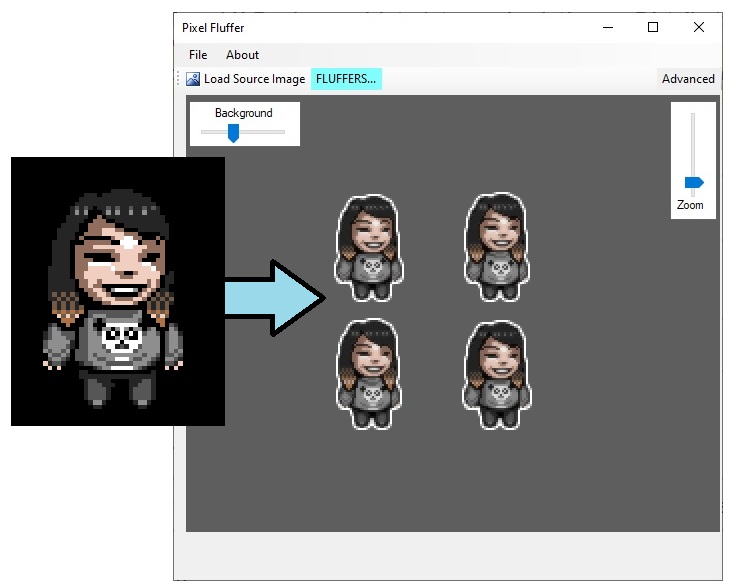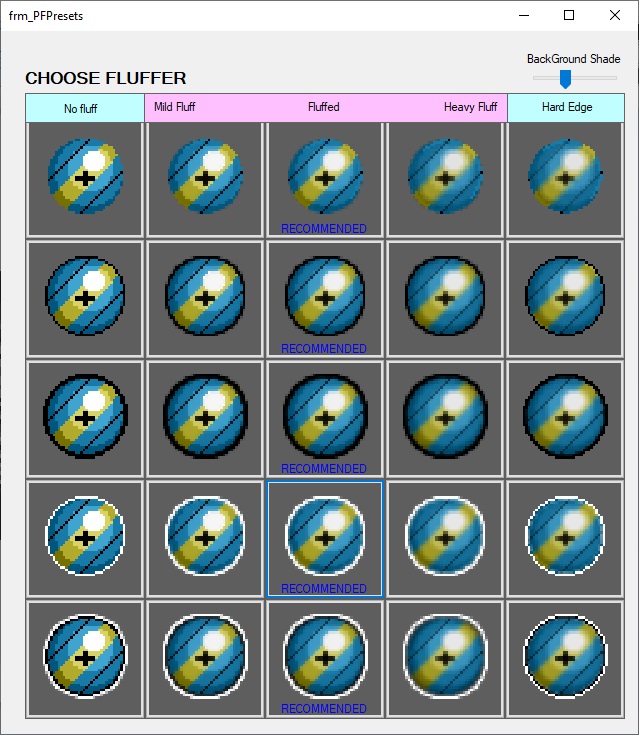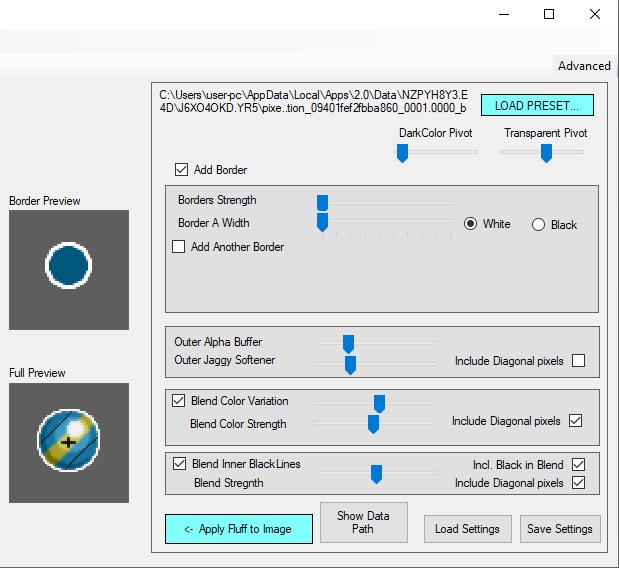Pixel Fluffer - A FREE tool to adjust your pixel art.
Save yourself hours of pixel-placement. Now you can animate your sprites with the bare minimum of colors and let Pixel Fluffer add the finishing touches.
This tool is now complete and free to dowload at
https://mathbear.itch.io/pixel-fluffer
REQUIRES Windows 10
Features include :



This tool is now complete and free to dowload at
https://mathbear.itch.io/pixel-fluffer
REQUIRES Windows 10
Features include :
- Choose from a list of preset Fluffer filters.
- Fine tune your favorite Fluffer in the advanced settings.
- Add a White and/or Black outline to each sprite.
- Soften jagged edges.
- Smooth together simple shades of color to create a smooth transition.
- Subdue inner dark pixels to blend more naturally with the surrounding colors.
- Achieve a softened effect, while controlling the desired level of pixilation.





PFI2.jpg
732 x 588 - 63K


PFI3.jpg
639 x 735 - 168K


PFI4.jpg
619 x 568 - 85K

Comments
https://www.patreon.com/saint11
http://www.effectgames.com/demos/worlds/
An alternative to the blending that you're doing might be to use some kind of dither pattern. It's not for every game (we've been avoiding it in Broforce, although occasionally some old art's slipped through), but it's the more traditional way that blending's been done in the past. In particular, you might want to look at the Bayer Matrix, which is one way to dither somewhat smoothly. (This image comes from the Aseprite community -- Aseprite is by far the best pixel art editor I've used so far, in case you haven't tried it. It has an outline filter like yours.)
--
That said, I think there's a more fundamental problem with your current approach, which is that typically when you're modelling forms in art, and you're doing shading, different forms require different amounts of shading. Sometimes you do want forms to be very smooth (like the round part of a cylinder), but at other times you want it very sharp (like the two edges of a cylinder). This is true of almost every real-world object. Applying a "blur"-like algorithm to an entire image just makes it blurry. It's the selective blurring that makes something look like it's being shaded rather than the camera being out of focus. I don't know how you'd do that exactly; maybe it'd require tagging "hard" edges with a different colour, and having the blurring algorithm ignore those edges?
I agree that the sharpness and limited palette is very iconic in pixel art.
I reckon that since I'm using limited resolution, it still counts.
For me personally, I wanted the freedom to choose how much pixel sharpness to retain without painting a dozen shades and hues by hand. This program allows me to do that with the sliders. I don't have to abandon pixel sharpness entirely, and that is what I wanted.
In the sample above, there is still a distinct difference in the values... It is just somewhat more elaborate than the source data.
With your concern regarding flat edges on pipes.
That is a valid concern. I can probably build in some rules to test for flat edges and ignore or limit the blending. I will cross that bridge when I get there.
Dithering is a nice idea. It did cross my mind however, most of my game sprites are usually 32X32 or 64... In those cases, dithering requires a LOT of essential space (at least 5 pixels to be relevant) and with such limited real estate I would rather blend colors. But I might want to use this for larger sprites in the future... it wouldn't hurt to add a dithering option to the program. Thanks I'll keep that in mind.
Ultimately this is about saving time for me, by automatically doing what I normally do by hand.
The style in the end is the same as my manual work would have been, only now it has more consistency and less human error.
TAKEAWAY : Thanks for mentioning the flat edge dilemma. I didn't think of that at all, and so I really appreciate that input.
Starting with the SOURCE material....
GIMP's Blur effect decimates the detail (as expected)
Unity's Bi/Tri linear filtering is passable and kind of nice, but we lose all the pixel sharpness.
And then finally Pixel Fluffer... showing a nice clear distinction of pixels while still blending colors and softening borders.
I hope that this demonstrates my aim a bit better.
The fuzzy border looks much better with a white outline.
But toning it down on the black outline is quick and easy.
I just want to reduce the obvious jaggedness of black borders... working on some other methods to achieve that.
First... here is a sample where I address some of Steven's concerns regarding the blurry outline.
I hope this demonstrates that colors can be smoothed in moderation without resorting to full blown "blurring".
And to show that the blurry outline is completely optional, and not a default.
(I understand if the end result does not appeal to everyone. I guess at this point it has become a conversation around taste.)
So if there are any styles or tastes you would like to see me achieve (such as dithering) then let me know. I'm enjoying the tinkering process a lot.
The rest of this post is about a PREVIEW feature I added to let me preview the settings before applying them to the main sprite sheet.
If you are keen on more detail, then feel free to look through and comment or ask questions.
It is nowhere near perfect and I'm happy to get input and suggestions.
I made some good progress and enhancements.
The program now has an advanced method of clipping jagged edges and blending the borders into the original sprite.
I also added a quick preset menu so that users don't need to spend hours tweeking sliders.
The tool is now available for free on itch.io. (Though it requires Windows 10)
https://mathbear.itch.io/pixel-fluffer
See above for more details...
You considering a Mac port? (I'm volunteering to help if it's on the horizon)
Good work man!
Since that would require passing on the source code to somebody else, I feel a bit reluctant.
Essentially it would then become open source and I am still feeling a bit (perhaps unrealistically) precious about retaining ownership of the source code. Maybe that is just because the effort is still so fresh.
More likely I will port the code to unity instead, where I can deploy to any platform, and I can use high performance sharers instead to parse pixels.
That would be a big undertaking but it will open up many more possibilities such as using the tool inside your unity project itself, leading to instant visivle results as the source spritesheets can be converted as an added part of the import pipeline.
But that is not planned for the near future at all.
Right now my focus is on the Protoshi jams coming up, and it is struggling to get off the ground.